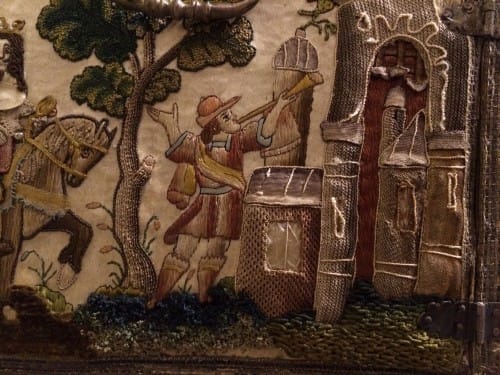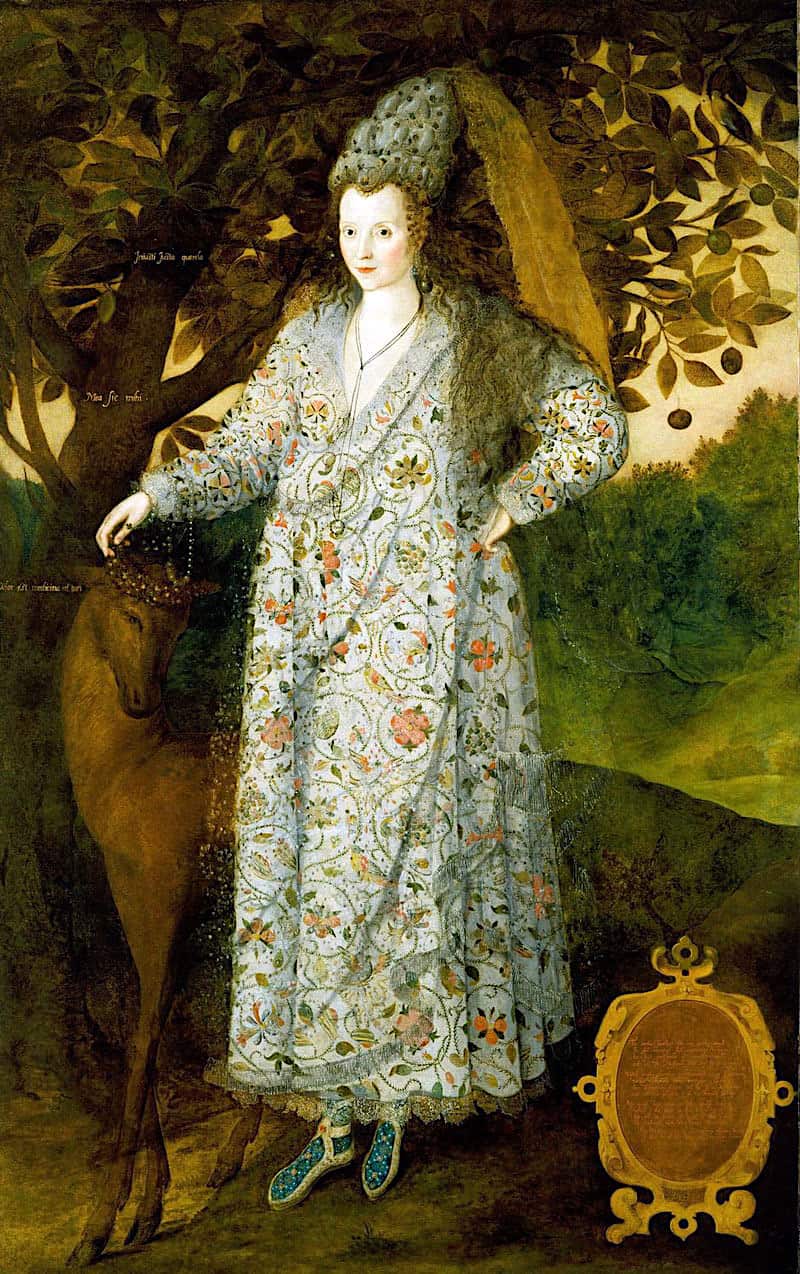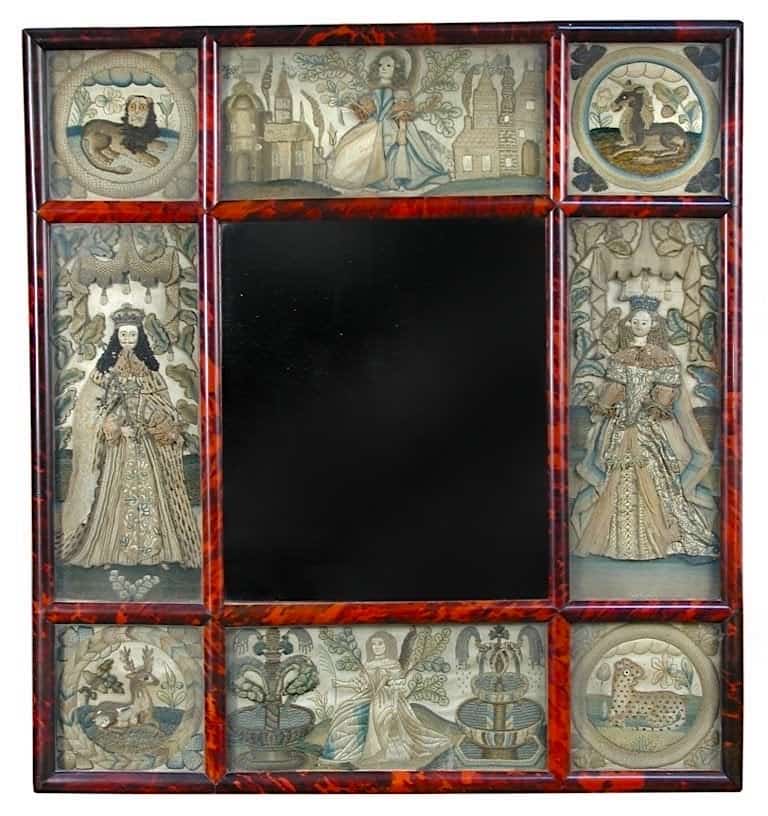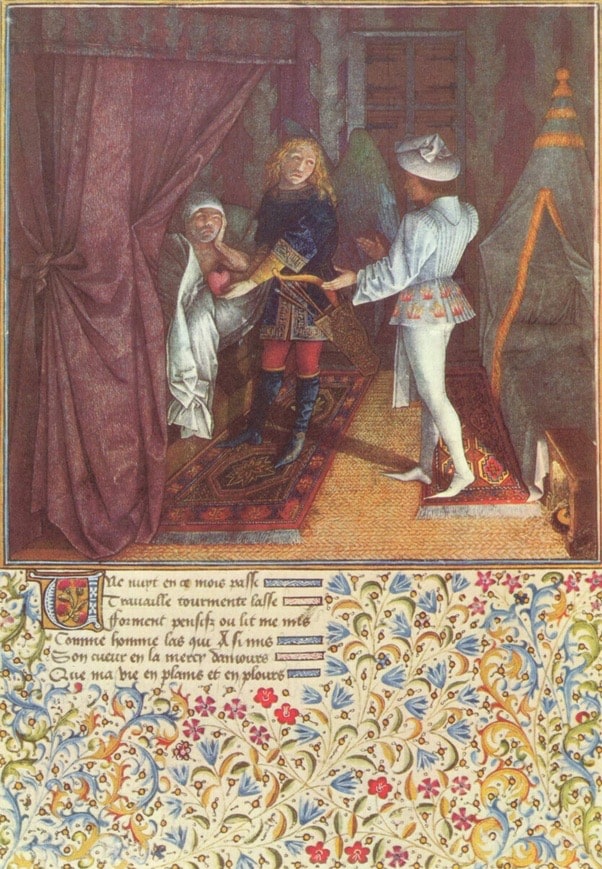18 Oct Jacobean Embroidery a Style Based on the Folklore of England
Jacobean Embroidery : We live in our current times in houses or apartments, which are fully furnished, heated in winter, and adorned extensively with textiles for aesthetic reasons and utility. But there was a time in England and the rest of the world that houses were draughty, furniture scarce, and cloth was restricted to wool, linen, and silk. There were rushes on the floor, which dogs and often people would relieve themselves in, making interiors malodorous. People often shifted from one house to another, an itinerant lifestyle because homes became quickly unhygienic.
In the 16th and 17th centuries, an awareness began to grow about beauty and comfort, both in interiors and dress. This age coincided with a time in England when huge homes were being built, abbeys were turned into residences, and lasting peace meant that they could give attention to aesthetic
These developments meant an increased demand for textiles like curtains, bed covers, cushions, and apparel. With the formation of East India Company in 1600 and Palampores and chintz imports from India, motifs like the Tree of Life became familiar in England.


Enormous progress was made in dyes at this point in history, giving access to a broader range of bright colors.
Jacobean embroidery, a style based on fanciful motifs
With this background, Jacobean embroidery came into existence and flourished. Jacobean was the Latin name for King James 1, who ruled England and Scotland in the early 17th century and, after whom this embroidery got its name.
Jacobean embroidery is not so much an embroidery technique, but far more a style based on fanciful motifs like plants, vines, animals, birds, and mythical creatures like the unicorn in the folklore of England. And of course, the Tree of Life and other motifs inspired by Indian textiles.



Crewelwork Embroidery
Much of Jacobean embroidery, but not all, is crewelwork, which is raised embroidery in wool, of which the most famous example is the Bayeux Tapestry, which relates the tale of the Norman Conquest through its motifs. The earlier wool embroidery traditions, especially the church’s tradition, heavily influenced the Jacobean Crewel Work. Much Crewelwork of this period uses blues, lovely greens, and pinks and browns as accents.



Stumpwork Technique in Jacobean Embroidery
The other vital technique is stumpwork, which is similar to Crewelwork in being raised and layered but uses a combination of metal and silk threads. Jacobean stumpwork is almost three-dimensional and often incorporates wire, seed pearls, beads, and semi-precious stones for its finished effect. It uses wire and stitches separately to create forms, which are then affixed to the main fabric with more wires, making the unmatchable raised visual effect.



Jacobean embroidery was used to adorn furnishings and apparel and caskets, embroidered wall hangings, and frames, many of which have survived in a better condition than clothing.



Jacobean embroidery Atelier
Interestingly, the practice of Jacobean embroidery was by men working in ateliers. Each member of the atelier worked on the work specific to his skill, of course, in keeping with the time’s craft traditions.
The craft was considered important enough to have a society called “Keepers and Wardens of the Art and Mistery of Broderers” who reviewed finished works and destroyed those they believed below par!
The Jacobean style eventually fell out of favor in the reign of Queen Anne, giving way to lighter and more fashionable embroidery. Its legacy lives on in numerous needlework workshops, home embroidery kits, and organizations like the Royal School of Needlework in England.



READ MORE
THE MUGHAL EMPERORS LOVE FOR BEAUTIFUL FLOWERS AND FLORAL DESIGNS
PAISLEY A GENUINELY GLOBAL MOTIF IN THE DESIGN WORLD
TOILE DE JOUY, THE FABRIC SYMBOLIC OF FRENCH SAVOIR-FAIRE
A HUMBLE ORIGIN & FASCINATING STORIES OF FASHIONABLE MADRAS CHECKS
HANDWOVEN DIAPHANOUS MUSLIN, THE STORY OF THE WORLD’S FINEST FABRIC
FRENCH ART DECO TEXTILE MOVEMENT’S STRONG INFLUENCE ON DESIGN
NATURAL DYES – THE HISTORY OF EXTRACTION OF BEAUTIFUL PLANT PIGMENTS
MATISSE’S ART AND TEXTILES. HOW TEXTILE STIMULATED HIS CREATIVE POWERS TO A NEW PICTORIAL REALITY
ANIMAL PIGMENTS – THE HISTORY OF EXTRACTION OF BEAUTIFUL NATURAL PIGMENTS
MUGHAL & DUTCH: A CULTURAL BRIDGING OF 2 GREAT ARTISTIC TRADITIONS





No Comments